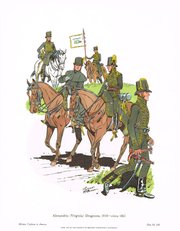This is the fourth of a series of articles telling what Alexandrians did 200 years ago during the War of 1812. For earlier articles in this series, go to alexandriagazette.com.
Main Sources
Alexandria Gazette; Daily National Intelligencer; Will of John Wise, Alexandria Orphans Court Will Book 2; “Artisans and Merchants of Alexandria, 1780-1820,” by T. Michael Miller
At 5:30 on the evening of Tuesday, June 21, 1814, a number of Alexandria cavalrymen were sitting on their horses on a hill overlooking the village of Benedict, Md. on the Patuxent River, about 40 miles southeast of Washington. Below them, they could see several British barges and ships anchored in the river near the village.
Most of the British navy had departed the Chesapeake Bay in September the year before, leaving only a skeleton blockading squadron. However, in late February 1814, the British returned to the bay in force and resumed the pattern of shore raids it had pursued the previous year. Then Napoleon’s defeat freed even more men and ships to fight in the Chesapeake.
Thus, this June evening, part of the British fleet had sailed up the Patuxent River to strike fear into the inhabitants there, and to explore the river for possible future operations.
Two days earlier, an express rider had ridden into Washington with the urgent message that the British were in the Patuxent River and had “burnt many dwellings and plundered a number of families” on the river’s shores. In response, a force of District of Columbia militia — infantry, artillery and the cavalrymen from Alexandria, then part of the District — were assembled quickly in Washington and began marching toward the river.
The cavalry had ridden out ahead of the other units and were the first to reach the hills overlooking Benedict, where they found the British. The cavalrymen were citizen soldiers. The Alexandrians were led by Captain William F. Thornton, who normally would have been in Alexandria behind his druggist counter. With him on the hill was Alexander Hunter, 24 years old, whose store on King Street sold groceries, spirits, and gunpowder. Also mounted on his horse on the hill was Francis Wise, the 27-year-old-son of John Wise, the owner of the hostelry today called Gadsby’s Tavern. Although they did not know it, one of them was about to become the first Alexandria militiaman killed in the War of 1812.
On the hills above Benedict, they joined a small group of Maryland militia led by General Phillip Stuart, who also had been seeking the British. Two accounts of what happened next have survived. One was printed in Washington’s Daily National Intelligencer, and the other appeared in the Alexandria Gazette.
Looking down from their hill, the cavalrymen saw in the distance the British vessels near the village. Closer, at the foot of their hill, they spotted “a small detachment of the enemy, probably a marauding party.” Immediately, the order was given to charge. The troopers obeyed with “much haste and impetuosity.”
Dashing down the hill and onto level ground, the cavalrymen quickly overtook three or four British soldiers on foot and took them prisoner. Continuing, the galloping horsemen pursued a group of several soldiers and a sergeant into an adjoining field. There, after a brief fight, they captured two or three of the soldiers and killed another, but the sergeant got away. A few cavalrymen went after him.
The Gazette version continues:
“Among the first who overtook him was Mr. Francis Wise of the Alexandria Dragoons who made a bold but unsuccessful assault upon him. Being unable to check his horse, [Wise] passed 10 or 15 paces beyond him. On turning his horse, Wise received the fire of the sergeant and fell dead. At this moment Mr. Alexander Hunter, a young gentleman of this town came up.” As the sergeant turned and faced Hunter, Hunter fired at him with his pistol, “which seemed to take effect.”
Then: “Mr. Hunter’s horse being alarmed at the [pistol’s] report ran some distance from the spot. When Mr. H. returned he found Gen. Stuart engaged with this intrepid soldier. He immediately advanced to the general’s relief – upon which the sergeant having had his bayonet unshipped [disengaged from his musket], dropped his musket and mounting an adjoining fence fell upon the other side on his back.
“His escape appearing certain unless pursued, Mr. H. begged the loan of a sword which was presented to him by the general, and with which he alone pursued and soon overtook [the sergeant]. . . . A conflict ensued between them, the brave enemy endeavoring by many and vigorous efforts to get possession of the sword and refusing — though repeatedly urged — to surrender except with his life.” Soon his life, in fact, was ended with a stroke of Hunter’s sword.
Meanwhile, the remainder of the marauding party had run back to their barges and ships in the river. The British vessels immediately opened up “a very brisk fire of round and grape shot” on the exposed Americans. General Stuart, seeing that the remainder of the British party had reached safety, ordered the Americans to retreat to the hills. They did so, amazingly without further injury.
The British soldiers taken prisoner told the Americans that the slain sergeant was Sergeant Major Mayeaux or Mayo of the Royal Marines, with 17 years of active service and a man “of great personal prowess.” He, Trooper Wise, and the British soldier slain earlier were buried “with the honors of war, by the Alexandria troop” near where they were killed. Today their burial place is marked at Oldfields Episcopal Church near Hughesville, Md.
Two weeks later, the citizens of Georgetown gave the returning soldiers a rousing, celebratory dinner with a suitable number of toasts. The celebration, however, turned out to be premature.
